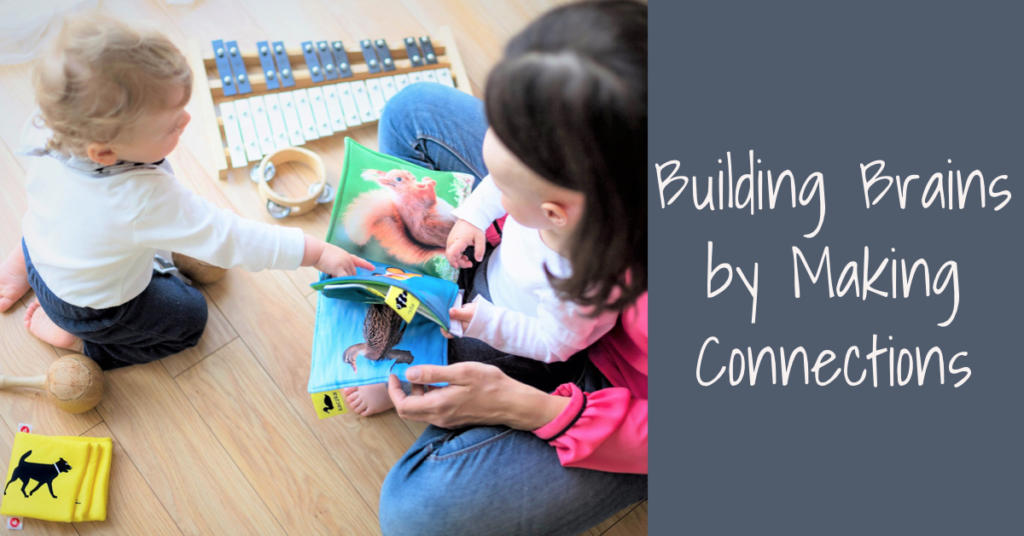Building Brains by Making Connections
October 25, 2021 | Brain Development
Connecting You to Your Child and Connecting Your Child to Good Books and the World Around Us
by Susan Bennett-Armistead, Ph.D. and Gabriel Civiello, M.D.
(excerpted from ‘Building Brains by Making Connections,’ published in Parent & Family, March 2, 2016)

“Read to your child 20 minutes a day!” “1000 books before kindergarten!” “Start them off right! Read to them!”
We’ve all heard the public service announcements telling us how important it is to read to our children. What we rarely hear, however, is WHY we’re supposed to be doing all this reading, WHEN are we supposed to start, and WHAT types of things are we supposed to be reading?
We are the Early Literacy and Clinical Advisors to Raising Readers, a program that, thanks to generous funding from the Libra Foundation, has distributed over 3 million high-quality books to Maine children aged birth to five through their healthcare providers for over 20 years. One of us is a pediatrician in the MaineHealth system and the other is a professor of early literacy at the University of Maine. Together, we hope to answer some of the common questions we mentioned in the first paragraph. We’ll also share with you some ideas for making the most of the time you spend reading to the children in your life.
Why is Reading and Making Connections with Children So Important?
Research tells us that reading aloud to children makes a big difference in their brain development; it serves a critical role in giving them language to identify things in the world around them and the ability to make connections between life experiences. It also helps them create important pathways they will use later in life to learn important skills and information. Furthermore, reading is a powerful way for adults to bond with children in a meaningful way, creating feelings of trust, safety, and love.
The good news is that it is never too early to start reading to a child. Evidence suggests that even young infants are developing language recognition skills. (Kuhl, 1992, 2004) We know that shared book reading at 4 months is associated with better expressive language skills during the toddler years (Karras 2005). Studies also suggest that the amount of reading materials in the home, the frequency of library visits, having adults model literacy behaviors and the amount of time adults spend reading with children predicts language‐based literacy skills in kindergarten and second grade (Griffin 1997). It is a chain of evidence that suggests reading aloud should start early and be done often to promote literacy skills and educational attainment.
Reading Aloud Builds Knowledge about Our World
Another benefit of reading aloud is that it builds world knowledge for children to draw on not only when reading but later when they are writing or trying to understand new information (Vivas, 1996). For example, you reading a book about sharks to your four year old may well lead her to a degree in marine biology or it may just make her more aware of biodiversity when talking about what kinds of animals live in coral reefs in her high school biology class. Either way, the time spent reading aloud with a caring adult enhanced a later experience and gave the new learning something to connect to.
References
- Griffen EA, Morrison FJ. (1997) The Unique Contribution of Home Literacy Environment to Differences in Early Literacy Skills. Early Child Development and Care Volume 127, Issue 1, pages 233-243
- Karras, J. & Braungart-Rieker, J. (2005). Effects of shared parent-infant book reading on early language acquisition. Applied Developmental Psychology, 26, 133-148.
- Kuhl PK, Williams KA, Lacerda F, Stevens KN, Lindblom B. (1992) Linguistic experience alters phonetic perception in infants by 6 months of age. Science. Jan 31;255(5044):606-8.
- Kuhl PK. (2004) Early language acquisition: cracking the speech code. Nat Rev Neurosci. Nov;5(11):831-43.
- Vivas, E. (1996). Effects of story reading on language. Language Learning, 46, 189-216.
